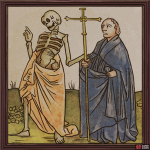Text
The basic form of greeting was a bow and varied according to the occasion and the importance of the person being greeted. A slight bow with a hand gesture to the heart was used by nobles of equal rank. A deeper bow was considered a more respectful greeting (guest, respect to a higher-ranking individual).
The next level was kneeling on the left knee and lowering the head. This greeting was used towards rulers, barons, or high-ranking commanders and expressed subservience. Rising was only allowed upon the invitation of the person being greeted. The final level was bowing on both knees, a gesture of complete subjugation, often associated with a plea (especially for mercy).
Doffing headwear began to be practiced under the influence of “Burgundian fashion” in the 15th century. Loyalty was expressed by kissing the rings of magnates and prelates. Women’s hands were not kissed, but they were given a deeper bow than would be appropriate given their status.
Precise conventions also applied to addressing or mentioning a particular person (e.g., in text): for example, a townsman should be referred to as “honest,” a squire as “worthy,” and a banner lord as “noble.”
In the countryside, people greeted each other according to their nature, often mentioning in the greeting wishes of good health, prosperity and God’s blessing, or making reference to Christian tradition (God bless, Christ be praised etc.)


No Comments